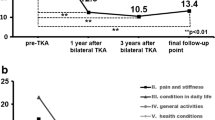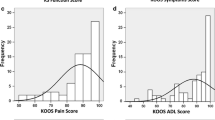Abstract
Purpose
Evaluations for knee osteoarthritis (OA) or post-operative total knee arthroplasty (TKA) have mainly been assessed by objective scales. Though the Knee injury and Osteoarthritis Outcome Score (KOOS) is attracting attention as a patient-based outcome score, the relationship with conventional objective scales after TKA remains controversial. The purpose of this study was to investigate the relationship between KOOS and conventional objective scales and evaluate the features of patient-based outcome scores.
Methods
Subjects were 130 post-operative patients involving 186 knees treated with TKA. Their mean age was 74.0 ± 8.0 years, and the follow-up period was 43 months. Japanese Orthopaedic Association (JOA) score, original Knee Society Score (KSS) and surgeon’s satisfaction score were scored as conventional objective scales besides KOOS. Spearman’s correlation coefficient was estimated between these scales. Comparisons between OA and rheumatoid arthritis (RA) as well as primary and revision surgery were performed by the Mann–Whitney U test.
Results
There were strong correlations between KOOS activities of daily living (ADL) and JOA score (r = 0.806), KSS function score (r = 0.803) and between KOOS pain and KSS knee score (r = 0.689). However, there was a poor correlation between KOOS and surgeon’s satisfaction score (r = 0.188-0.321). TKA for RA showed poorer results only in KOOS pain (p = 0.003), and revision surgery showed poorer results in KSS function, KOOS symptoms and KOOS quality of life (QOL).
Conclusions
This study suggested that conventional objective scales reflected mainly ADL disturbances in post-operative TKA patients. Furthermore, patient-based outcome scores made it possible to evaluate and detect a minute change of knee pain and QOL in TKA patients. The Japanese KOOS was a useful tool to evaluate conditions after TKA.


Similar content being viewed by others
References
Yoshimura N, Muraki S, Oka H, Mabuchi A, En-Yo Y, Yoshida M, Saika A, Yoshida H, Suzuki T, Yamamoto S, Ishibashi H, Kawaguchi H, Nakamura K, Akune T (2009) Prevalence of knee osteoarthritis, lumbar spondylosis, and osteoporosis in Japanese men and women: the research on osteoarthritis/osteoporosis against disability study. J Bone Miner Metab 27:620–628
Felson DT (1988) Epidemiology of hip and knee osteoarthritis. Epidemiol Rev 10:1–28
Muraki S, Akune T, Oka H, Ishimoto Y, Nagata K, Yoshida M, Tokimura F, Nakamura K, Kawaguchi H, Yoshimura N (2012) Physical performance, bone and joint diseases, and incidence of falls in Japanese men and women: a longitudinal cohort study. Osteoporos Int 24:459–466
Zhang W, Nuki G, Moskowitz RW, Abramson S, Altman RD, Arden NK, Bierma-Zeinstra S, Brandt KD, Croft P, Doherty M, Dougados M, Hochberg M, Hunter DJ, Kwoh K, Lohmander LS, Tugwell P (2010) OARSI recommendations for the management of hip and knee osteoarthritis: part III: changes in evidence following systematic cumulative update of research published through January 2009. Osteoarthritis Cartilage 18:476–499
Gill GS, Chan KC, Mills DM (1997) 5- to 18-year follow-up study of cemented total knee arthroplasty for patients 55 years old or younger. J Arthroplasty 12:49–54
Maniwa K, Ishibashi Y, Tsuda E, Yamamoto Y, Inoue R, Otsuka H (2013) Accuracy of image-free computer navigated total knee arthroplasty is not compromised in severely deformed varus knees. J Arthroplasty 28:802–806
Dalury DF, Ewald FC, Christie MJ, Scott RD (1995) Total knee arthroplasty in a group of patients less than 45 years of age. J Arthroplasty 10:598–602
Keenan AC, Wood AM, Arthur CA, Jenkins PJ, Brenkel IJ, Walmsley PJ (2012) Ten-year survival of cemented total knee replacement in patients aged less than 55 years. J Bone Joint Surg Br 94:928–931
Schai PA, Scott RD, Thornhill TS (1999) Total knee arthroplasty with posterior cruciate retention in patients with rheumatoid arthritis. Clin Orthop Relat Res 367:96–106
Manopoulos P, Havet E, Pearce O, Lardanchet JF, Mertl P (2012) Mid- to long-term results of revision total knee replacement using press-fit intramedullary stems with cemented femoral and tibial components. J Bone Joint Surg Br 94:937–940
Bellamy N, Buchanan WW, Goldsmith CH, Campbell J, Stitt LW (1988) Validation study of WOMAC: a health status instrument for measuring clinically important patient relevant outcomes to antirheumatic drug therapy in patients with osteoarthritis of the hip or knee. J Rheumatol 15:1833–1840
Roos EM, Toksvig-Larsen S (2003) Knee injury and Osteoarthritis Outcome Score (KOOS)—validation and comparison to the WOMAC in total knee replacement. Health Qual Life Outcomes 1:17–26
Ware JE Jr, Sherbourne CD (1992) The MOS 36-item short-form health survey (SF-36). I. Conceptual framework and item selection. Med Care 30:473–483
Brazier JE, Harper R, Jones NM, O’Cathain A, Thomas KJ, Usherwood T, Westlake L (1992) Validating the SF-36 health survey questionnaire: new outcome measure for primary care. BMJ 305:160–164
Akai M, Doi T, Fujino K, Iwaya T, Kurosawa H, Nasu T (2005) An outcome measure for Japanese people with knee osteoarthritis. J Rheumatol 32:1524–1532
Nakamura N, Takeuchi R, Sawaguchi T, Ishikawa H, Saito T, Goldhahn S (2011) Cross-cultural adaptation and validation of the Japanese Knee Injury and Osteoarthritis Outcome Score (KOOS). J Orthop Sci 16:516–523
Lingard EA, Katz JN, Wright RJ, Wright EA, Sledge CB, Kinemax Outcomes Group (2001) Validity and responsiveness of the Knee Society Clinical Rating System in comparison with the SF-36 and WOMAC. J Bone Joint Surg Am 83-A:1856–1864
Okuda M, Omokawa S, Okahashi K, Akahane M, Tanaka Y (2012) Validity and reliability of the Japanese Orthopaedic Association score for osteoarthritic knees. J Orthop Sci 17:750–756
Ghanem E, Pawasarat I, Lindsay A, May L, Azzam K, Joshi A, Parvizi J (2010) Limitations of the Knee Society Score in evaluating outcomes following revision total knee arthroplasty. J Bone Joint Surg Am 92:2445–2451
Insall JN, Dorr LD, Scott RD, Scott WN (1989) Rationale of the Knee Society clinical rating system. Clin Orthop Relat Res 248:13–14
Insall JN, Binazzi R, Soudry M, Mestriner LA (1985) Total knee arthroplasty. Clin Orthop Relat Res 192:13–22
Yagishita K, Muneta T, Ikeda H (2003) Step-by-step measurements of soft tissue balancing during total knee arthroplasty for patients with varus knees. J Arthroplasty 18:313–320
Bradbury N, Borton D, Spoo G, Cross MJ (1998) Participation in sports after total knee replacement. Am J Sports Med 26:530–535
Scuderi GR, Bourne RB, Noble PC, Benjamin JB, Lonner JH, Scott WN (2012) The new Knee Society Knee Scoring System. Clin Orthop Relat Res 470:3–19
Nilsdotter AK, Toksvig-Larsen S, Roos EM (2009) A 5 year prospective study of patient-relevant outcomes after total knee replacement. Osteoarthritis Cartilage 17:601–606
Conflict of interest
The authors declare that they have no conflict of interest.
Author information
Authors and Affiliations
Corresponding author
Rights and permissions
About this article
Cite this article
Sasaki, E., Tsuda, E., Yamamoto, Y. et al. Relationship between patient-based outcome score and conventional objective outcome scales in post-operative total knee arthroplasty patients. International Orthopaedics (SICOT) 38, 373–378 (2014). https://doi.org/10.1007/s00264-013-2064-5
Received:
Accepted:
Published:
Issue Date:
DOI: https://doi.org/10.1007/s00264-013-2064-5




